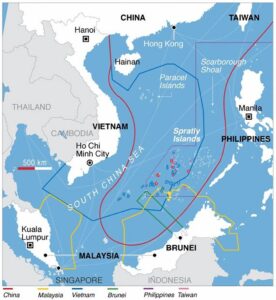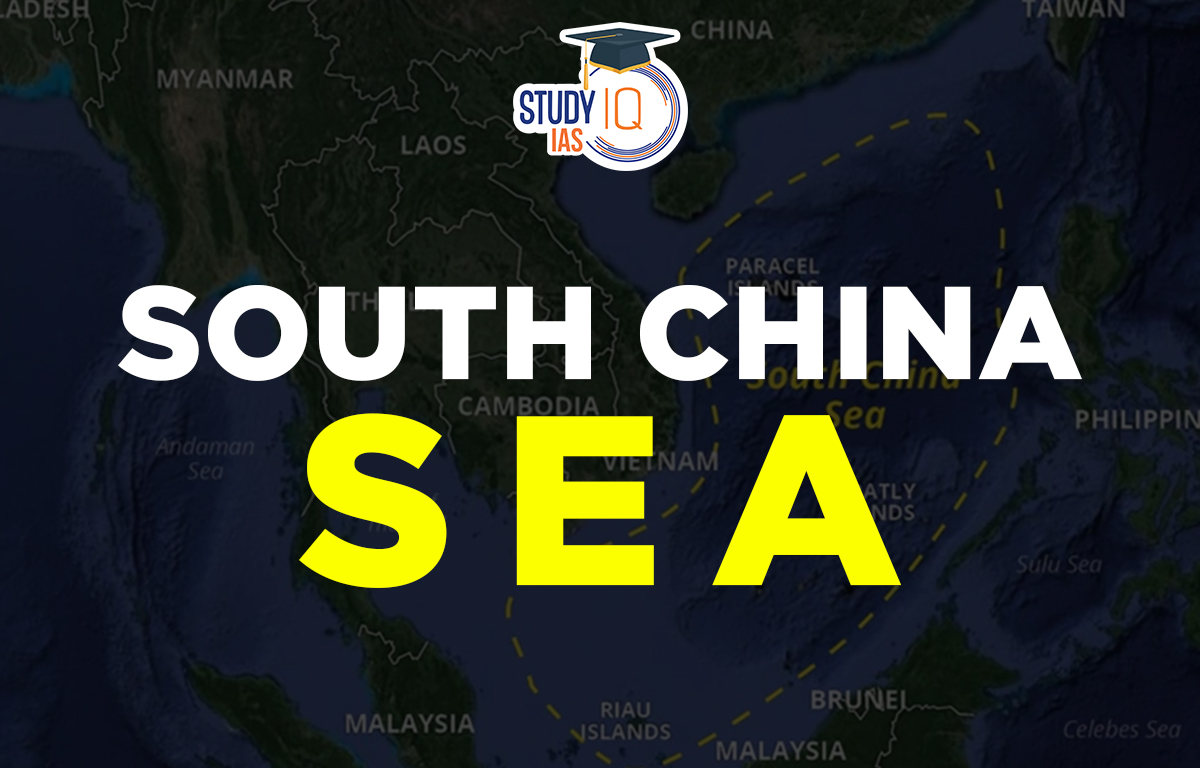Table of Contents
South China Sea
The South China Sea is one of the busiest waterways in the world, serving as a vital trade and merchant shipping route. The South China Sea disputes are maritime and island claims between the region’s sovereign states. These disputes involve China, Brunei, Taiwan, the Philippines, Vietnam, and Malaysia, all of which are geopolitically located in the Indo-Pacific region.
Read about: Indian Ocean
South China Sea Countries
The South China Sea is a branch of the western Pacific Ocean in Southeast Asia. South of China, east and south of Vietnam, west of the Philippines, and north of Borneo are its neighbouring countries. Taiwan Strait connects it to the East China Sea, and Luzon Strait connects it to the Philippine Sea. From north to south, the countries are:
- The People’s Republic of China
- The Republic of China (Taiwan)
- The Philippines
- Malaysia
- Brunei
- Indonesia
- Singapore
- Vietnam
South China Sea Strategic Importance
Because of its location, this sea is extremely strategic because it connects the Indian and Pacific Oceans (Strait of Malacca). According to the United Nations Conference on Trade and Development (UNCTAD), it carries one-third of global shipping, carrying trillions of dollars in trade, making it a significant geopolitical water body.
Read about: Pacific Ocean
South China Sea Map
Here is a map of the South China Sea given below for a better understanding:

Read about: Indian Ocean Dipole
South China Sea Dispute
China’s Claim Over South China Sea
China claims almost the entire South China Sea, including the Paracel Islands. Taiwan, the Philippines, Brunei, Malaysia, and Vietnam all claim territory in the region, which is thought to contain valuable oil and gas deposits. It claims that a US warship entered the territorial waters of China’s Xisha (Paracel) island without permission from the Chinese government, accusing the US of “seriously violating China’s sovereignty” and “harming regional peace.”
China’s Assertion Over South China Sea
Since 2010, China has been converting uninhabited islets into artificial islets in order to bring them under the UN Convention on the Law of the Sea (examples would include Haven Reef, Johnson South Reef and Fiery Cross Reef). China has been modifying the physical land features of the reefs to alter their size and structure. It has also built airstrips on the islands of Parcel and Spratly.
Chinese fishing fleets are more interested in paramilitary work for the state than in commercial fishing. The US strongly condemns China’s construction of artificial islands and refers to it as erecting a “great wall of sand.”
South China Sea US’s Position
The United States has argued that such exercises are in accordance with international law and help defend the right of passage through the region in the face of competing claims by China and other governments.
It is consistent with the United States’ ongoing efforts to counter China’s assertion in SCS. The United States Navy recently sent an aircraft carrier group into the South China Sea.
Read More: India-China Border Dispute
Reasons for Dispute in the South China Sea
- China, Taiwan, and Vietnam all claim the Paracel Islands.
- China, Taiwan, Vietnam, Brunei, and the Philippines all claim the Spratly Islands.
- The Philippines, China, and Taiwan all claim the Scarborough Shoal.
Read about: India Pakistan Border Dispute
South China Sea Other Issues
- The South China Sea’s geographic scope is unknown.
- Disagreement on dispute resolution mechanisms.
- The undefined legal status of the Code of Conduct (COC) adds to the problem.
- The various histories of distant, largely uninhabited sea archipelagos complicate and multifaceted the situation.
South China Sea India’s Stand
India has maintained that it is not a party to the SCS dispute and that its presence in the SCS is to protect its own economic interests, particularly its energy security needs. However, China’s growing ability to decide and expand its role in the South China Sea has forced India to reconsider its position.
As part of the Act East Policy, India has begun internationalising disputes in the Indo-Pacific region in order to counter China’s threatening tactics in the South China Sea.
Furthermore, India is leveraging its Buddhist heritage to forge strong ties with the Southeast Asian region. India has also deployed its navy in the South China Sea with Vietnam to protect sea lanes of communication (SLOC), denying China any room for assertion. In addition, India is a member of the Quad initiative (India, the United States, Japan, and Australia) and the lynchpin of the Indo-Pacific narrative. China sees these initiatives as a containment strategy.
Read More: Ocean Waves
South China Sea UPSC
China has recently made headlines for unilaterally altering the situation on the ground in the South China Sea. It is expanding its presence in the SCS in the midst of the global coronavirus pandemic. It agreed to the formation of two districts to administer the disputed Paracel and Spratly Islands in the South China Sea.
Previously, Beijing had given new names to 25 islands or reefs and 55 undersea entities in the South China Sea in an attempt to reassert its sovereignty over the region. This article provides pertinent facts on the South China Sea dispute from the standpoint of the UPSC/ IAS Exam.
Read More: Ocean Currents


 Story of Meera Bai and Her Devotion For ...
Story of Meera Bai and Her Devotion For ...
 Desert Climate, Distribution, Climatic C...
Desert Climate, Distribution, Climatic C...
 Deserts of India Map, Features of Thar D...
Deserts of India Map, Features of Thar D...





















